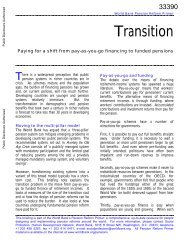Financial Sector Development in Africa: Opportunities ... - World Bank
Financial Sector Development in Africa: Opportunities ... - World Bank
Financial Sector Development in Africa: Opportunities ... - World Bank
You also want an ePaper? Increase the reach of your titles
YUMPU automatically turns print PDFs into web optimized ePapers that Google loves.
The Potential of Pro-Market Activism for F<strong>in</strong>ance <strong>in</strong> <strong>Africa</strong>: A Political Economy Perspective 185<br />
services <strong>in</strong>creases private <strong>in</strong>vestment rema<strong>in</strong>s limited because of the nonrandom<br />
nature of <strong>in</strong>terventions: although private banks favor serv<strong>in</strong>g<br />
governments and large companies, activist policies tend to target lessdeveloped<br />
sectors and companies. The associated selection bias complicates<br />
the identification of the causal impact of activist policies on the<br />
private sector. Third, the returns of activist policies may be long term,<br />
which makes it difficult to assess the success of more recent—and <strong>in</strong> the<br />
short term, sometimes even distort<strong>in</strong>g—activist policies.<br />
For these reasons, the follow<strong>in</strong>g historical overview of experience with<br />
activism adopts a broad def<strong>in</strong>ition of what constitutes a successful activist<br />
policy. While a narrow def<strong>in</strong>ition would consider activist policies to<br />
be successful only when they <strong>in</strong>crease <strong>in</strong>vestment and economic, sectoral,<br />
or enterprise development, policies are also categorized as successful<br />
<strong>in</strong> this section if they <strong>in</strong>crease the outreach of f<strong>in</strong>ancial services to the<br />
target group.<br />
Decades of market-replac<strong>in</strong>g activism. In the 1960s and 1970s governments<br />
<strong>in</strong> develop<strong>in</strong>g countries were expected to play a prom<strong>in</strong>ent role <strong>in</strong><br />
the f<strong>in</strong>ancial sector. In l<strong>in</strong>e with welfare economic theory, the consensus<br />
was that the lack of bank f<strong>in</strong>ance for private <strong>in</strong>vestment was a result of<br />
market failures (Gerschenkron 1962). Ma<strong>in</strong>stream economic th<strong>in</strong>k<strong>in</strong>g<br />
held that an active public sector <strong>in</strong>volvement <strong>in</strong> mobiliz<strong>in</strong>g and allocat<strong>in</strong>g<br />
f<strong>in</strong>ancial resources was called for to overcome market failures <strong>in</strong> order to<br />
broaden access to f<strong>in</strong>ance for groups and sectors that were shut out of the<br />
formal f<strong>in</strong>ancial market. These excluded groups <strong>in</strong>cluded poor households,<br />
agriculture, and sectors depend<strong>in</strong>g on long-term f<strong>in</strong>ance. This activist<br />
approach toward f<strong>in</strong>ancial sector development was part of a broader<br />
<strong>in</strong>terventionist agenda that regarded governments as drivers of the development<br />
process and sought to replace markets that failed to generate<br />
growth and substantially reduce poverty.<br />
The ma<strong>in</strong> <strong>in</strong>strument for broaden<strong>in</strong>g access to f<strong>in</strong>ance <strong>in</strong> develop<strong>in</strong>g<br />
countries dur<strong>in</strong>g the period of market-replac<strong>in</strong>g activism was directly<br />
provid<strong>in</strong>g funds through public or development banks. By the 1970s, the<br />
state <strong>in</strong> develop<strong>in</strong>g countries owned, on average, 65 percent of the assets<br />
of the largest banks, compared with about 40 percent <strong>in</strong> developed countries<br />
(De la Torre, Gozzi, and Schmukler 2007, 13). In those countries<br />
that had adopted central plann<strong>in</strong>g and had nationalized the bank<strong>in</strong>g<br />
system—such as Gu<strong>in</strong>ea, Tanzania, and Ben<strong>in</strong>—government-owned<br />
banks constituted the entire bank<strong>in</strong>g system. Governments used public or<br />
development banks to support the pursuit of their developmental agenda







